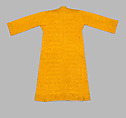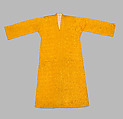Quilted Coat with Long Sleeve and Aqal Head Cord
Not on view
This ensemble includes a quilted coat and an aqal head cord. An aqal head cord is part of a man’s traditional ensemble in the Arab world that kept a head covering in place and was often worn together with an abaya cloak. This ornate example features large bulbs made of orange silk and metal-wrapped thread and was also an important symbol of social status and authority.
The coat with its long sleeves is characteristic of the dress and centuries-old luxurious silk textiles woven in Syria in the large urban workshops of Aleppo and Damascus. In the nineteenth and early twentieth centuries, coats like this yellow example were made of fine satin silk and quilted in vertical bands of stylized floral bands or geometric stripes, often with zigzag borders or other simple repeat designs. Open to the front, these garments are constructed with long sleeves and often have pockets on the sides. An inner lining in simple undyed cotton protects the outer fabric and provides additional padding. Although white to yellow quilted coats seem more popular, blue and red examples are known as well. Such coats were intended for Syrian women and girls from wealthy families living in urban centers. Typically worn after bathing, such luxurious coats were among the preferred garments to in the bridal trousseau. Research also suggests that similar quilted coats were preferred by Sufi Shaykhs in Anatolia and worn as a hırka coat over layers of clothing. These coats worn in Anatolia are referred to as hırka coats "from Syria". The Syrian denomination of the Sufi coats speaks to Syria’s fame for fine clothing and silk manufacture.
Due to rights restrictions, this image cannot be enlarged, viewed at full screen, or downloaded.
This artwork is meant to be viewed from right to left. Scroll left to view more.







